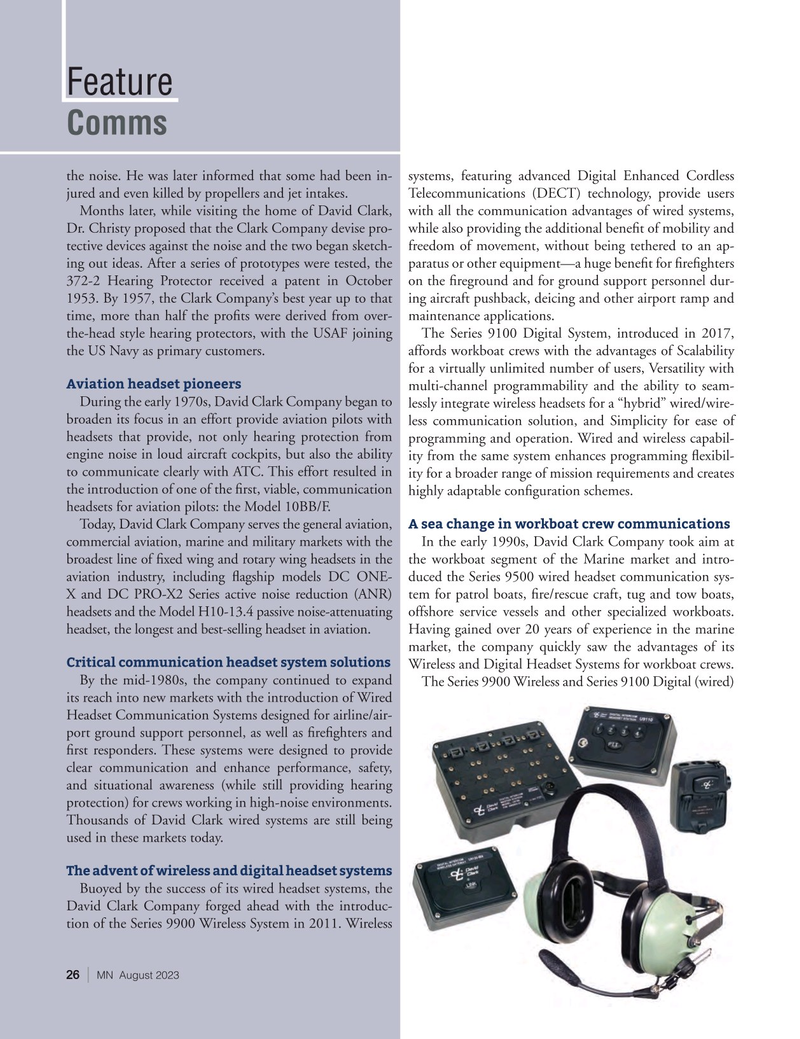
Page 26: of Marine News Magazine (August 2023)
Boatbuilding & Repair
Read this page in Pdf, Flash or Html5 edition of August 2023 Marine News Magazine
Feature
Comms the noise. He was later informed that some had been in- systems, featuring advanced Digital Enhanced Cordless jured and even killed by propellers and jet intakes. Telecommunications (DECT) technology, provide users
Months later, while visiting the home of David Clark, with all the communication advantages of wired systems,
Dr. Christy proposed that the Clark Company devise pro- while also providing the additional bene? t of mobility and tective devices against the noise and the two began sketch- freedom of movement, without being tethered to an ap- ing out ideas. After a series of prototypes were tested, the paratus or other equipment—a huge bene? t for ? re? ghters 372-2 Hearing Protector received a patent in October on the ? reground and for ground support personnel dur- 1953. By 1957, the Clark Company’s best year up to that ing aircraft pushback, deicing and other airport ramp and time, more than half the pro? ts were derived from over- maintenance applications.
the-head style hearing protectors, with the USAF joining The Series 9100 Digital System, introduced in 2017, the US Navy as primary customers. affords workboat crews with the advantages of Scalability for a virtually unlimited number of users, Versatility with
Aviation headset pioneers multi-channel programmability and the ability to seam-
During the early 1970s, David Clark Company began to lessly integrate wireless headsets for a “hybrid” wired/wire- broaden its focus in an effort provide aviation pilots with less communication solution, and Simplicity for ease of headsets that provide, not only hearing protection from programming and operation. Wired and wireless capabil- engine noise in loud aircraft cockpits, but also the ability ity from the same system enhances programming ? exibil- to communicate clearly with ATC. This effort resulted in ity for a broader range of mission requirements and creates the introduction of one of the ? rst, viable, communication highly adaptable con? guration schemes. headsets for aviation pilots: the Model 10BB/F.
Today, David Clark Company serves the general aviation,
A sea change in workboat crew communications commercial aviation, marine and military markets with the In the early 1990s, David Clark Company took aim at broadest line of ? xed wing and rotary wing headsets in the the workboat segment of the Marine market and intro- aviation industry, including ? agship models DC ONE- duced the Series 9500 wired headset communication sys-
X and DC PRO-X2 Series active noise reduction (ANR) tem for patrol boats, ? re/rescue craft, tug and tow boats, headsets and the Model H10-13.4 passive noise-attenuating offshore service vessels and other specialized workboats. headset, the longest and best-selling headset in aviation. Having gained over 20 years of experience in the marine market, the company quickly saw the advantages of its
Critical communication headset system solutions
Wireless and Digital Headset Systems for workboat crews.
By the mid-1980s, the company continued to expand
The Series 9900 Wireless and Series 9100 Digital (wired) its reach into new markets with the introduction of Wired
Headset Communication Systems designed for airline/air- port ground support personnel, as well as ? re? ghters and ? rst responders. These systems were designed to provide clear communication and enhance performance, safety, and situational awareness (while still providing hearing protection) for crews working in high-noise environments.
Thousands of David Clark wired systems are still being used in these markets today.
The advent of wireless and digital headset systems
Buoyed by the success of its wired headset systems, the
David Clark Company forged ahead with the introduc- tion of the Series 9900 Wireless System in 2011. Wireless 26 | MN August 2023

 25
25

 27
27
